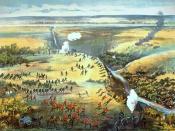The Fish
Elizabeth Bishop's poem The Fish narrates the changing attitude of the speaker towards the fish. First, the fish is described as ancient and grizzled, showing signs of death and decay. However, upon closer inspection, the fish is made out to be a survivor of many battles. Through the use of figurative language, the poet shows the speaker's shift from noting only the fish's dejection to admiring him for his past glories.
Bishop begins with the personification of the fish into a figure of defeat and age. The speaker mentions that the fish had not fought at all, as though he had given up all hope. She compares the fish's skin to old wallpaper which would not be securely attached to the wall as skin loses firmness with age. In addition, Bishop details the extent of the fish's injuries, everything from lice and barnacles to the fresh blood of his wounds.
Such imagery invokes feelings of decay and abandonment as parasites are allowed to slowly consume him. The speaker also contemplates the fish's innards, suggesting that his has become a mass of flesh and bone without spirit. The speaker furthers the personification of the fish by looking into his eyes and remarking that he had not looked back fully. Instead, the fish had only shifted his stare a little towards the light, further suggesting lack of will while giving the fish a very human feeling of dejection. Not caring about the face of his conqueror, the fish only seeks to confront death, represented by the light that he turns towards. The focus on the fish's physical structure denotes the fish's lack of spirit yet it is this very lifelessness that gives the fish the human emotions of apathy and hopelessness. Through the personification of the fish, the poet...


